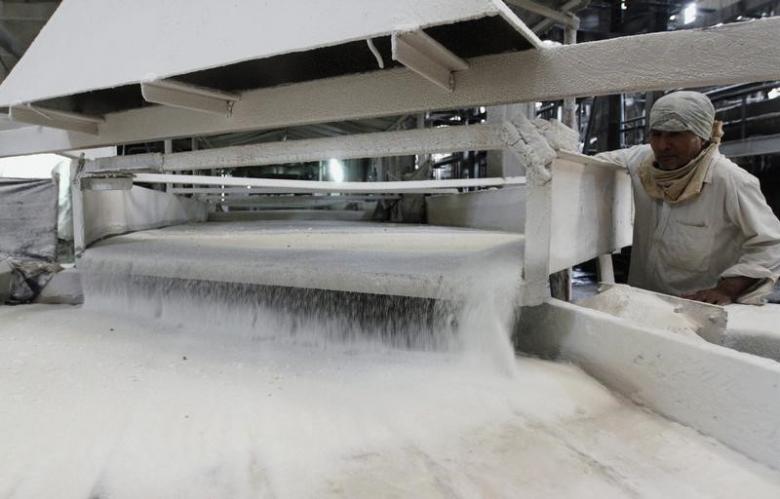
The 2019 China Sugar Expo and World Sugar Seminar was held in Guangxi, a province whose produced sugar accounts for 60% of China’s total sugar output. At the venue of hundreds of people, can the reporter find any signs of the previously reported 300,000 tons of imported Pakistani sugar?
“I’ve been studying sugar all my life, but I still don’t know who’s in charge of the sugar price,” said Jia, who did not respond directly to the sugar issue, pointing straight at the price of sugar.
According to Jia, China’s sugar-making enterprises lost 1.9 billion yuan last year, and most of the main producing areas are in the border, and poor areas with leftover children and the elderly, including Xinjiang, Inner Mongolia, Guangxi, Yunnan, and Guangdong.
China’s sugar farmers are about 40 million, and their income contributes around 70% of the sales income of sugar enterprises.
Such a high proportion of sugarcane farmers’ income mainly refers to the purchasing price of sugarcane, that is, the raw material price from sugar enterprises.
At the intervals of the meeting, Xu Sheng, a senior researcher of white sugar at the agricultural sector from Shanghai Chaos Investment Co Ltd, analysed three reasons why the purchasing price of sugarcane in China could not be reduced. First, the difficulty of mechanised planting, second is the increase in labour costs, and third, the rigidity of land rent.
“There are many sloping fields in the south, it is difficult to drive jeeps, let alone popularising mechanised production. Now that sugarcane cutters have been paid no less than 120 yuan per mu of land, the sugar factory will not be able to bring down the purchasing price of 490 yuan per ton for sugar farmers,” said Xu Sheng.
Joining in the sugar price discussion, Wang Jiabo, a senior researcher of SDIC ESSENCE Futures, remarked, “Recently, some sugarcane farmers have seen a fall in sugar prices and a rise in fruit prices, so they intended to give up sugarcane planting, turn to fruit planting. Next year, Guangxi may have competition in the planted area, if this figure falls domestically, we will see a rising market.”
In the process of exploring the sugar market, various views and remarks on sugar price bring to mind the nickname “demon sugar”, since the domestic sugar commodity prices go up and down, and with unpredictable mystery. The market mentioned above is the domestic sugar prices.
When talking about domestic sugar prices, the most discussed is ‘sugar No 11’ – New York raw sugar futures, FOB prices of 29 sugar producers around the world, which is an indicator of international raw sugar prices. Moreover, the key factor that connects domestic and international sugar prices is import tariff.
In 2019, the in-quota tariff rate of 1.945 million tons of imported sugar in China is 15%, and the out-quota import tariff is applied to the trade guaranteed rate of 85%, with 70% difference between.
“Every country has protection measures against its domestic sugar prices, so does the United States and Japan. Japan has the highest import tariffs of 100%,” said Wang.
The price of ‘sugar No 11’ would drop to 11.62 cents per pound and $256 per ton (about 1,856 yuan), after a likely rebound from 85% to 50% a year later, Brazil’s Ministry of Agriculture said on May 21.
On the same day, the spot prices of domestic coastal ports were between 5,300 yuan and 5,400 yuan, and the price difference between futures and spot was 3,544 yuan per ton.
According to survey data from the research group of the Agricultural Trade Promotion Centre of the Ministry of Agriculture, the price of ‘sugar No 11’, with additional out-of-quota tariff, freight charges and refined processing in China, tumbled to 3,900 yuan in September 2014.
Even though the average price of domestic sugar had sunk to the lowest in the same period, it was 100 yuan higher than the refined after-tax price of imported raw sugar. Therefore, it is self-evident that the industry is sensitive to international sugar imports, especially low-priced imported sugar.
“Pakistan will certainly benefit from selling sugar to China with high sugar prices, but their low-priced sugar will bring impact on our domestic market. And China’s 40 million sugar farmers will absolutely have to surrender part of the profits. As far as we know, 182,000 tons of Pakistani sugar has gone through customs clearance, whether the next 120,000 tons will be settled within the year, I don’t know yet,” commented Xu Sheng, who was the first among the participants to mention Pakistani sugar.
Since the domestic sugar industry is so concerned about the import of Pakistani sugar, the total sugar import and its distribution among the major sugar-producing countries is also the core concern.
Jia Zhiyan said at the sidelines of the event that China’s annual average import of sugar from 2011 to 2018 was 3.46 million tons. “China’s total import each year is planned. If there is more of this, there will be less of that,” he said.
Martin Todd, General Manager of UK LMC International, believes that Pakistan does not have a sustained supply capacity for sugar export and has a higher probability of one-off export to China.
In mid-April, in an interview in Lahore, Adviser to PM on Commerce Abdul Razak Dawood said that China’s first $1 billion special access for Pakistan, including sugar, rice and yarn, has been launched. As this first $1 billion agreement is completed, China will grant a second $1 billion special access.
The director-general of the International Sugar Organisation, Joseph Orif, believes that Pakistan has sugar stocks this year and that special access next year is likely to be replaced by other categories.
A sugar researcher, who spoke on condition of anonymity, gave the reporter a retail price list of sugar in Pakistan. “After the export to China, the price of sugar in Pakistan has gradually risen, surging by over 20% in April compared with the same period last year. As far as we know, sugar may not be expected to be exported next year.”
This article originally appeared on the China Economic Net
Published in The Express Tribune, June 10th, 2019.
Like Business on Facebook, follow @TribuneBiz on Twitter to stay informed and join in the conversation.

1723278472-0/BeFunky-collage-(4)1723278472-0-165x106.webp)


1719564405-0/BeFunky-collage-(19)1719564405-0-165x106.webp)

1732486769-0/image-(8)1732486769-0-270x192.webp)










COMMENTS
Comments are moderated and generally will be posted if they are on-topic and not abusive.
For more information, please see our Comments FAQ